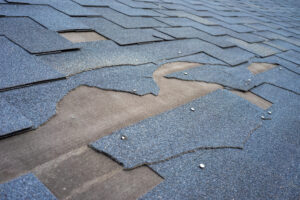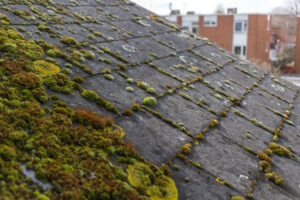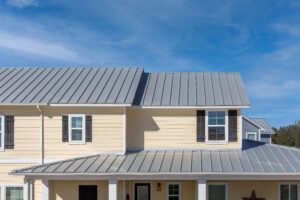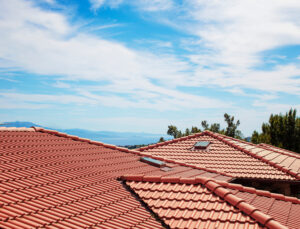Roofing Installation – Where to Start and What to Consider

*Updated November 20th, 2025
Your roof is one of the most critical components of your home, safeguarding it from the elements and maintaining its structural integrity. A solid roof protects against water damage, mold growth, and insulation problems that can affect your home’s energy efficiency and overall comfort. However, roofs have a limited lifespan, and wear and tear are inevitable over time.
While some roofing issues can be resolved with simple repairs, there are times when a full roof installation is the best option to ensure your home remains safe and secure. Deciding whether to repair or replace your roof requires a clear understanding of your roof’s current condition, the costs involved, and the long-term benefits of each option. Here’s a comprehensive guide to help you evaluate your needs and make the right decision for your home.
Should you Repair or Replace your Roof?
1. The Roof’s Age
Knowing your roof’s age will tell you if it needs replacing. If you’re at the end of the roof’s life, it’s better to replace than repair it. Each type of roof has a different lifespan, and different brands may vary too.
For instance, shingled roofs usually last 20 years, but metal roofs last much longer, sometimes up to 50 years.
2. Water Damage
Sometimes a roof’s damage is so extensive that you have water damage in your attic and on ceilings. If water damage goes undetected too long, it can cause structural damage to your home.
Inspecting your roof for leaks and potential water damage can help you determine if it’s a simple repair or if the entire roof needs replacement.

3. Damaged Shingles
Damaged shingles don’t automatically mean you need a new roof, but it could be a sign. A licensed roof contractor can determine if only a few shingles need repairing or if replacing the entire roof is more cost-effective and safe for your home.
4. Damaged Flashing
If your flashing is damaged, it may be able to be repaired as long as the damage isn’t too extensive. Slight damage is repairable, but extensive damage or wear and tear could signify it’s time for a new roof.

5. Mold Growth
If a roofing contractor notices mold on shingles, you could have a problem inside your home. Often with mold, you must remove the old roofing, remove the mold, and replace it with a new roof. If you see signs of water damage, checking for mold is important.
6. Sagging
If your roof is sagging, it’s a sign that it needs a complete replacement, including a tear-off of the old roof. Sagging signifies that the boards underneath the roof are rotted and could give out if not replaced.
7. Energy Efficiency
An old or damaged roof can impact your home’s energy efficiency, causing higher heating and cooling bills. If your roof isn’t adequately insulating your home, replacing it with more energy-efficient materials can save money in the long run.
8. Frequent Repairs
If you find yourself constantly repairing your roof, the cumulative cost may exceed the expense of a full replacement. Consider how often repairs have been needed and whether it’s time to invest in a longer-term solution.
9. Local Weather Conditions
Your area’s climate plays a significant role in your roof’s condition. Frequent exposure to storms, heavy snow, or extreme heat can accelerate wear and tear. If your roof has been through severe weather events, it may be wise to consider a replacement.
10. Roofing Material Compatibility
If your home has been updated or remodeled, your current roofing material might no longer suit your needs or style. Replacing it could enhance both functionality and aesthetic appeal.
11. Resale Value and Curb Appeal
If you plan to sell your home soon, replacing an outdated or damaged roof can significantly increase its value and curb appeal, making it a worthwhile investment.
12. Inspection Results
Professional roof inspections can uncover underlying issues you might miss. If a roofing contractor identifies multiple problems or safety concerns during an inspection, replacement may be the safest choice.
Types of Roofing to Consider
If you decide it’s time for a new roof, you may have several options depending on where you live and what most people in the area use.
Here are the top roofing types.
1. Asphalt Shingles
Asphalt shingles are the most affordable roofing option but have the shortest lifespan. They work in all climates and environments and work well with home design.

2. Metal Roofs
Metal roofs take on the appearance of more expensive materials, such as shake, slate, or tile. They can last as long as 50 – 80 years and work well in high winds, snow, and rainy areas. In addition, metal roofs require the least amount of maintenance.
3. Slate Roofs
Slate roofs last even longer than metal roofs, sometimes as long as 100 years. In addition, slate is waterproof, so it works well in wet or damp climates. The downside is that it is much costlier and heavy, making it suitable for only certain homes.

4. Clay Tiles
Clay tiles are also more expensive, but they can withstand excessive winds. They are another heavy option that requires support to keep it up. They are best used in areas with tornadoes or earthquakes.
Roofing Considerations Based on Climate
When choosing your roof materials, you should consider the climate the home experiences year-round. Choosing a roof that can withstand the elements around you ensures a longer-lasting and more affordable option.
Humid or Cold Weather
If the weather around you is humid or cold, asphalt shingles work best. They are prevalent in the midwestern states but work well in other areas. Asphalt shingles don’t buckle under humidity and, if treated with algaecides, won’t deteriorate. They’re also great for pulling in heat to keep the house warmer.
Extreme Hot or Cold Weather
If your area has extreme hot or cold weather, consider metal roofing. In hot weather, it will keep your home cooler because the sun reflects off the roof rather than letting your home absorb the heat. It also is resistant to moisture and mold.
If your area has extreme cold weather or snow, metal roofing allows snow and ice to slide off, reducing the risk of damage to the structure or mold growth due to moisture. If you live in an area that’s extremely cold, it’s important to know how to winterize your roof.
Non-Humid Areas
You can consider wood shingles or shakes if your climate has no humidity. Unfortunately, these options don’t work well in hot or humid climates because they aren’t mold resistant and can buckle or split under water pressure.
Wood shingles or shakes are great in all climates, including wind, rain, and hail, because they are strong.
Hot and Humid Areas
Clay tiles are great for hot and humid areas and are the typical choice in these climates. They have a distinct look that’s consistent with the area. However, their largest benefit is their ability to resist heat, keeping the home cool without excessive energy use.
Questions to Ask your Contractor
Whether you’re considering a roof repair or replacement, you need a reputable contractor to handle the job. Here’s what to ask of your contractor.
1. Personal Questions
First, get to know your contractor and ask questions about his experience, including:
- How long have you been in business?
- Who is the owner, and for how long?
- Do you have a local office?
- Are you licensed, bonded, and insured?
The answers to these questions will tell you immediately if the contractor is worth talking to further. If the contractor doesn’t have a local office or just started his business, you may want to look elsewhere. You’ll often find storm chasers who bounce from area to area, taking advantage of people who need immediate roof repair or replacement.
Instead, you want a company that’s local, works in all conditions in your area and knows the area well.
2. Questions about the Crew
Next, ask a contractor about the crew working on your home. Typically they don’t have their own crew, but hire out. You deserve to know who will be on your roof.
- How do you find the crew that will work on my roof?
- Is the crew licensed, bonded, and insured?
- What type of training does the crew have?
- How do you pay your contractors?
- How do you protect your workers’ safety?
3. Questions about Past Work
Roofing contractors should be proud of their work and willing to share it. Ask contractors the following questions:
- What local jobs have you done recently?
- Do you have reviews I can read?
- Can I visit your completed homes and/or talk to the customers?

4. Questions about the Job
If you like the answers to the above questions, it’s time to ask the contractor about your job, specifically including the following:
- How soon could you schedule the job?
- How long will the job take?
- Will you apply for the building permits?
- How will you protect my home?
- Will you haul away the old materials?
- What types of warranties are provided?
Will you Consider Solar in the Future?
A significant consideration when determining if you should repair or replace your roof is if you’re considering going solar in the future.
Solar panels are heavy and put stress on your roof. A roof inspection is necessary to ensure the roof can handle the stress. If you know you’ll install solar panels in the next couple of years and the roofing contractor determines your roof isn’t in the best condition, you may consider a replacement now.
This will reduce your costs when you are ready to install solar panels and prevent you from wasting money on roof repairs when it will need replacing before installing solar panels.
FAQ
What goes on a roof first?
Before you can have a roof, you need a frame. If the framing is solid, you may not have to tear it off. Depending on the material and roof condition, your roofing contractor may be able to layer the roof.
What is the cheapest roof to install?
Asphalt shingles are the cheapest roofing material. However, they last the least time and need replacement more often.
What kind of roof lasts the longest?
Concrete or clay tiles last the longest but are only good in certain climates. The best roof for your area is the one that can withstand the temperature and weather conditions without damage or prematurely breaking.
To find a Local Roofing Pro who can help you, click here!
Final Thoughts
Choosing a roof repair or replacement is a big decision! Roofing installation must be done by qualified experts with a history of good work in your area. In addition, you want someone who understands how to inspect a roof, determine if you need a replacement, or if you can repair the damages and still have a solid structure.
If roofing installation is necessary, you want to choose the roofing material that works the best for your area, fits in with other homes around you, and will stand the test of time.
Additional Roofing Resources
- Can You Install a Metal Roof Over Shingles?
- What Are Architectural Shingles?
- Homeowner’s Guide to GAF Shingles
- Partial Roof Replacement: A Cost-Effective Solution for Targeted Roof Repairs

Anna has over six years of experience in the home services and journalism industries and serves as the Content Manager at MyHomePros.com, specializing in making complex home improvement topics like HVAC, roofing, and plumbing accessible to all. With a bachelor’s degree in journalism from Auburn University, she excels in crafting localized, comprehensive guides that cater to homeowners’ unique needs. Living on both coasts of the United States has equipped her with a distinctive perspective, fueling her passion for turning any house into a cherished home through informed, personalized decision-making.








